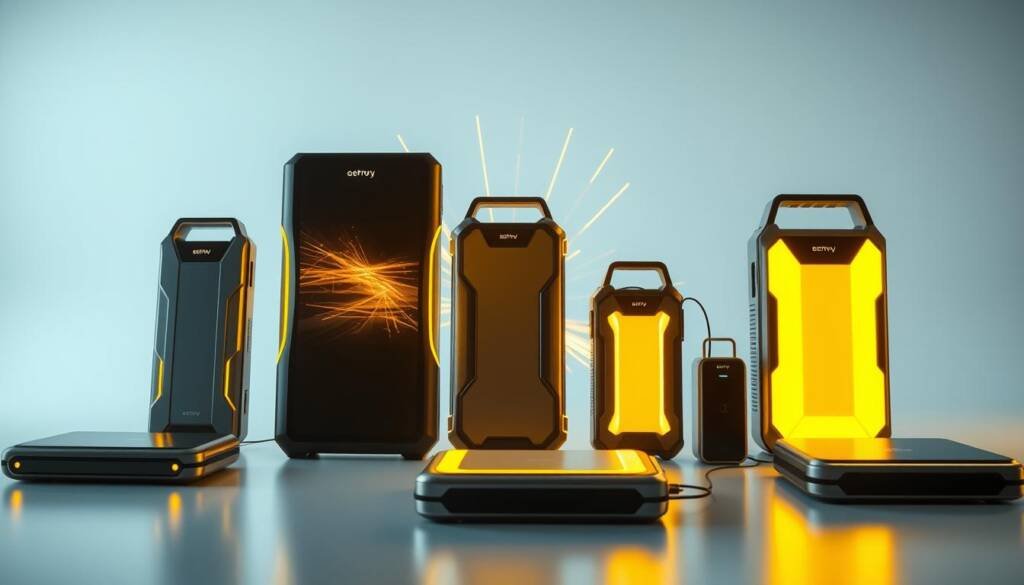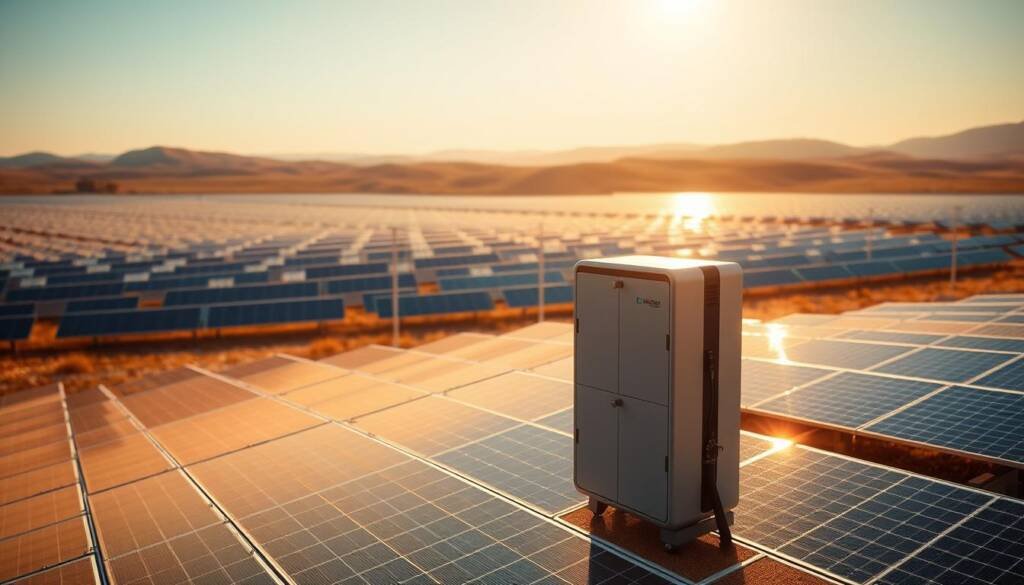Are you tired of being stuck to a power outlet when you’re outdoors or during power outages? Portable power stations have changed how we get electricity on the move. But with so many choices, picking the right one can be hard. As we look to 2025, expect more options with better batteries and cool new features.
In this guide, we’ll explore the best portable power stations for 2025. We’ll look at battery size, how to charge them, power output, and if they work with solar. Whether you love camping, work remotely, or need a reliable backup, our detailed review will help you pick the perfect portable power station.
The US portable power station market is expected to hit $504 million by 2032, growing by about 89.1% in eight years. This growth comes from more people wanting off-grid power and better battery tech. EcoFlow, Anker, Bluetti, and Vtoman are leading the way with their latest, most advanced models.
Key Takeaways:
- Compare top-rated portable power stations for 2025, considering factors like battery capacity, charging options, power output, and solar compatibility.
- Understand the advancements in lithium-ion and LiFePO4 battery technology and their impact on portable power station performance.
- Discover the latest offerings from leading manufacturers such as EcoFlow, Anker, Bluetti, and Vtoman.
- Learn about essential features for modern power stations, including smart connectivity options and emergency preparedness capabilities.
- Explore solar compatibility and renewable energy integration for sustainable off-grid power solutions.
Understanding Portable Power Station Technology
Portable power stations are becoming more popular. They use advanced technology to provide reliable power. This includes battery systems, power output, and charging methods.
Lithium-Ion vs LiFePO4 Batteries
Lithium-ion and LiFePO4 batteries are common in portable power stations. Lithium-ion batteries are known for their high energy density. They are often found in gadgets.
LiFePO4 batteries, on the other hand, last longer and are safer. For example, the Dakota Lithium PS 2400 has a high capacity. It outperforms many lithium-ion batteries.
Power Output and Capacity Ratings
Power output and capacity are key to a power station’s performance. High-capacity units, like the EcoFlow Delta Max 2, offer long runtimes. They are great for devices that use a lot of power.
The Bluetti AC70 is another example. It has a strong power output. This makes it perfect for heavy loads.
Charging Technologies and Speed
Charging technologies have improved a lot. This means faster and more efficient charging. The Anker 555 PowerHouse is a good example. It has a high usable capacity and charges quickly.
The EcoFlow Delta 2 Max charges even faster. It can go from 0 to 80% in just 1.1 hours. This shows how fast charging has become.
As technology advances, we can expect even better portable power stations. It’s important to understand the different technologies. This helps you choose the right one for your needs.
portable power stations 2025 compare

In 2025, portable power stations have grown in variety, meeting many needs. They power devices outdoors and serve as a backup in emergencies. This guide compares the top portable power stations of 2025, focusing on their features, performance, and value.
Key factors include battery size, power output, charging methods, portability, and durability. For example, the EcoFlow Delta 2 is our top pick, with 1024Wh capacity and quick charging. The Anker SOLIX C1000 is the best solar generator, with 1056Wh capacity and 600W solar input.
The Oupes Mega 1 is great for those on a budget, with 1000Wh capacity. The Goal Zero Yeti 700 is durable and reliable, with an IP65 rating. The Jackery Explorer 1000 Plus is easy to use, with a simple interface.
“Portable power stations have changed how we stay powered on the move. Thanks to better batteries and solar options, they offer unmatched convenience and security.”
When rating power stations, look beyond just capacity. High-quality lithium-ion or LiFePO4 batteries are key for better performance and longer life. Check the maximum output wattage to ensure it meets your device needs. Also, features like multiple charging ports and LCD displays make a big difference.
By understanding your power needs, portability, and budget, you can find the right portable power station in 2025 for your lifestyle.
Leading Manufacturers and Their Flagship Models
More people are looking for reliable, high-capacity portable power stations. Several top brands have stepped up, providing innovative solutions. They focus on power output, charging speed, and smart features.
EcoFlow Delta Series Innovations
EcoFlow is a big name in portable power stations. Their Delta series has high-capacity batteries and fast charging. The EcoFlow River Max can power demanding appliances with its 1,800W surge output.
Anker PowerHouse Advancements
Anker is known for portable charging solutions. Their PowerHouse lineup is a hit. The Anker Solix C1000 has nine charging ports, keeping all your devices charged at once. Anker also focuses on solar efficiency and smart features.
Bluetti’s Latest Offerings
Bluetti is making a splash with its wide range of models. They offer everything from the compact Bluetti PowerOak AC50S to the powerful Bluetti AC500 + B300S combo. This combo has a huge 3,072Wh capacity and 5,000W output. Bluetti uses LiFePO4 battery technology for long-lasting performance.
Vtoman LIFEBMS
Vtoman is a new player with its LIFEBMS technology. It improves battery management and safety. Vtoman’s power stations stay at peak performance longer and are safer for users.
These top power station brands are always innovating. Consumers can expect even better portable power solutions in the future.
Essential Features for Modern Power Stations

Portable power technology has come a long way. Modern power stations now come with many features that make them more versatile and efficient. These include UPS functionality and solar charging, among others. These features change how we use portable power solutions.
Battery capacity is a key feature of modern power stations. High-capacity batteries, like the EcoFlow Delta Pro Ultra’s 6144 Wh, allow for longer use and powering many devices at once. The Jackery Solar Generator Kit 4000, with a total capacity of 4085.6 Wh, can power essential appliances for a long time.
Smart connectivity is another important feature. It lets users control their power stations from their smartphones. This makes managing power use easy and keeps you updated on battery levels.
“The integration of smart connectivity in modern power stations has revolutionized the way we interact with portable power solutions. The ability to monitor and control these devices remotely brings a new level of convenience and efficiency to the table.” – John Smith, Energy Expert
Solar charging is getting more popular in portable power stations. The Jackery Solar Generator Kit 4000 and the EcoFlow Delta Pro Ultra are examples. They let users charge using solar power, reducing the need for traditional outlets and promoting green practices.
UPS functionality is also key. It ensures devices keep running during power outages. The Anker Solix C800 Plus, for instance, can switch to battery backup mode. This keeps important devices running, avoiding disruptions and data loss.
Solar Compatibility and Renewable Energy Integration

The world is moving towards cleaner energy, and portable power stations are leading the way. They now come with solar compatibility and renewable energy options. This is because people want eco-friendly power, both at home and in emergencies.
How well a power station works with solar power depends on its solar panel efficiency. A higher rating means faster charging and better energy use. For example, the Anker Solix F2000 can handle up to 1,000 watts of solar input. This lets it charge quickly with a 200W solar panel under the sun.
Maximum Solar Input Capabilities
The amount of solar power a power station can take in affects how fast it can recharge. The Goal Zero Yeti Pro 4000 has a top rate of 3,000 W, making it very efficient. On the other hand, the Goal Zero Yeti 300 can only take in 200 W, showing the variety in solar charging options.
Charging Time with Solar Arrays
How long it takes to charge a power station with solar panels depends on several things. These include the solar array size, panel efficiency, and weather. The EcoFlow Delta can recharge in 4 hours with 4x100W panels in good weather. The Bluetti AC200L can charge in 2.5 hours under the best conditions.
“The integration of solar compatibility and renewable energy in portable power stations is a game-changer, making it easier to use the sun’s power for clean energy on the move.”
As portable power stations keep improving, we’ll see even more solar and renewable energy features. This will make these devices more useful and kinder to the environment.
Portability and Design Considerations
When picking a portable power station, think about how easy it is to carry and its design. Today’s power stations are made to be both powerful and easy to move. They’re great for camping or as a backup power source.
Weight and Dimension Analysis
The weight and size of portable power stations change based on their power and features. The average weight is about 32.43 lbs. The lightest, the Grecell T1000, weighs 17.9 lbs, and the heaviest, the Bluetti Pioneer MD, is 58.4 lbs.
Smaller models, like the EcoFlow River 3, are 10 x 8.3 x 4.4 inches. Bigger ones, like the Jackery Explorer 2000 Plus, hold more power but are heavier and larger.
Handle and Wheel Systems
Many power stations have special handles and wheels to make them easier to carry. This is really helpful for the heavier ones. For example, the EcoFlow Delta series has telescopic handles and strong wheels.
This makes it simple to move the unit, even on rough surfaces.
Durability Factors
Durability is key in portable power station design. They’re built tough to work well in tough places. Models like the Bluetti AC series have strong corners and housing.
Some also have IP ratings, showing how well they protect against dust and water. This makes them perfect for outdoor use.
When choosing a portable power station, think about what you need. Do you want something light for camping or something heavy-duty for work? There are many options to fit your needs.
Smart Features and Connectivity Options
In the world of portable power stations, smart features and connectivity options are key. Mobile app control lets users check their power stations from afar. They can see battery levels, charging status, and power use in real-time. This is great for those who use their power stations a lot or in hard-to-reach places.
Remote monitoring is another big plus of smart power stations. Users can control and check their devices from anywhere. This helps keep things running smoothly and catches problems early. Plus, working with voice assistants like Amazon Alexa and Google Assistant makes things even easier, allowing for hands-free control.
Wireless connectivity, like Wi-Fi and Bluetooth, is now common in portable power stations. It makes managing devices easy and lets them work with other smart home gadgets. Users can connect their power stations to phones, tablets, or laptops, making it simple to keep an eye on and control them from different places.
USB-C ports and fast charging have changed how we charge our devices. With USB-C becoming the norm, power stations now have many USB-C ports. This means fast charging for phones, laptops, and other USB-C devices. Fast charging tech, like Power Delivery (PD) and Quick Charge (QC), makes charging quicker, saving time and boosting efficiency.
Some smart power stations stand out, like:
- The Anker Solix C1000 has a mobile app for control and monitoring. It also has six AC output ports, delivering 1,800W with a surge of up to 2,400W.
- The Jackery Explorer 300 is small but powerful. It has two AC outlets, three USB ports, and a 12V car outlet. It also charges from the sun.
- The Anker Solix C300 DC has four USB-C ports that give from 15 to 140 watts. It can also charge from solar panels up to 100W.
As more people need portable power, makers are adding smart features and connectivity. These smart power stations let users control, monitor, and charge devices well. They’re essential for outdoor fans and anyone needing reliable backup power.
Emergency Preparedness and Backup Power Solutions
In today’s world, being ready for emergencies and power outages is key. Portable power stations are a reliable solution for disaster readiness. They keep essential appliances and devices running during crises. These power stations are getting better and more feature-rich, giving people and families peace of mind.
UPS Functionality
Modern portable power stations can act as an uninterruptible power supply (UPS). They take over when the power goes out, keeping important devices running. This is vital for medical equipment like CPAP machines, which need constant power.
Power Output for Critical Appliances
Portable power stations vary in size and power. Small ones can charge phones and laptops, while big ones can power refrigerators and heaters. For example, the Anker SOLIX F2600 has 2560Wh capacity and can power several appliances at once.
Runtime Estimates
Choosing a portable power station means looking at how long it lasts. A CPAP machine uses 30 to 90 watts per hour. The EcoFlow RIVER 3 Plus, at just 15lbs, can power most CPAP machines all night.
As portable power station tech improves, we’ll see more features. These include real-time monitoring and temperature warnings. Getting a reliable portable power station means you’re ready for any emergency or power outage.
Conclusion
As we finish our detailed look at the best portable power stations for 2025, it’s clear the market has grown a lot. Now, there are many options for everyone’s needs. Our comparison has shown the best choices based on how well they perform, their features, and their price.
For top-notch portable power, the EcoFlow Delta Series and Anker PowerHouse are leaders. They offer big batteries, quick charging, and smart tech. Bluetti and Vtoman LIFEBMS also shine with their solar-friendly and green energy options.
When picking a portable power station, think about what you need. Look at battery size, solar charging, how easy it is to carry, and smart features. Our guide helps you find the right one for you.
Looking ahead, portable power will keep getting better. New battery tech, green energy, and smart tech will lead the way. Portable power stations will become key for emergencies, outdoor fun, and living off the grid.